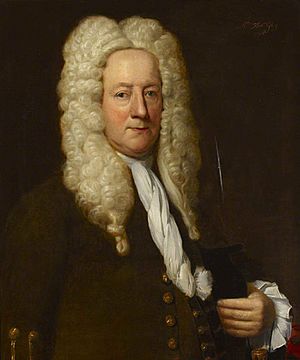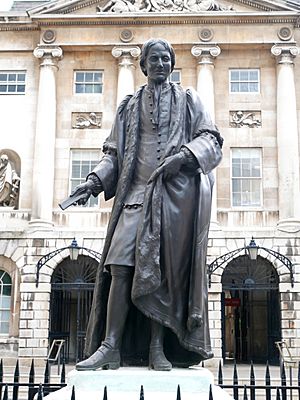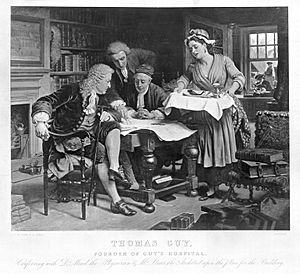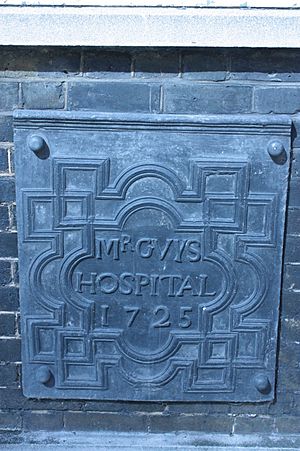Thomas Guy facts for kids
Quick facts for kids
Thomas Guy
|
|
|---|---|

Thomas Guy by John Vanderbank, 1706
|
|
| Member of Parliament for Tamworth | |
| In office 1695–1708 |
|
| Preceded by | Michael Biddulph, Sir Henry Gough |
| Succeeded by | Richard Swinfen, Henry Girdler |
| Personal details | |
| Born | 1644 Southwark, London, England |
| Died | 27 December 1724 (aged 79–80) |
| Occupation | Member of Parliament, bookseller, investor |
| Known for | Founder of Guy's Hospital |
Thomas Guy (born in 1644, died in 1724) was an important person in British history. He was a bookseller, meaning he sold books. He was also a Member of Parliament, which means he helped make laws for the country. Most famously, he started Guy's Hospital in London, a famous hospital that still helps people today.
Contents
Early Life and Education
Thomas Guy was born in Southwark in south London. His father moved goods by boat and sold coal. His family had different religious beliefs from the main church at the time. Thomas's mother, Anne, came from a respected family in Tamworth.
When Thomas's father died in 1652, his mother moved back to Tamworth with her children. Thomas likely went to the free grammar school there. This is where he got his education.
Starting a Book Business
In 1660, Thomas Guy returned to London. He became an apprentice to a bookseller and bookbinder named John Clarke. This training lasted eight years. During this time, London faced big events like the Great Plague in 1665 and the Great Fire in 1666.
In 1668, Thomas became a full member of the Stationers' Company. This group was important for anyone working with books. He also became a "freeman" of the City of London. This allowed him to open his own bookstore. His shop was located at a busy corner in London, where Lombard Street meets Cornhill.
At first, Guy brought in Bibles from the Netherlands. These Bibles were often better quality than those made in England. He also worked with other publishers to sell many different books. These included famous old stories and schoolbooks. Later, he got a special agreement from the University of Oxford to print Bibles under their license.
Helping His Hometown
Thomas Guy was a careful person with his money. After nine years in business, he started using his wealth to help others.
- In 1677, he paid for new buildings at the free grammar school in Tamworth. This was the same school he had attended.
- The next year, he built an almshouse in Tamworth. An almshouse is a place where poor people can live.
- In 1695, he was elected as a Member of Parliament for Tamworth.
- In 1701, he paid for a new Tamworth Town Hall.
However, in 1707, the people of Tamworth did not vote for him again. Thomas Guy was upset and decided not to help them anymore.
Smart Investments
By the late 1670s, Thomas Guy was making smart financial moves. He bought seamen's pay-tickets at a low price. He also loaned large amounts of money to landowners.
In 1711, these tickets became shares in the South Sea Company. This company was mainly set up to manage the government's debt. In 1720, Thomas Guy sold his shares before the company's value crashed. This event is known as the South Sea Bubble. He made a huge profit of about £175,000. He then put this money into other safe investments.
Founding Guy's Hospital
In 1704, Thomas Guy became a leader at St Thomas' Hospital in London. He gave a lot of money to this hospital over the years.
In 1721, after making a lot of money from his investments, he decided to start a brand new hospital. This hospital would be for people with long-term illnesses. Work on what became Guy's Hospital began that same year.
Thomas Guy never married. He died on December 27, 1724. He had already spent £19,000 on building the hospital. In his will, he left an amazing £219,499 to the hospital. This was the largest single donation to charity in the early 1700s. He also gave money to Christ's Hospital and many other charities. The rest of his money went to his family and friends.
On March 24, 1725, King George I officially approved the hospital. He thanked Thomas Guy for his great help to the public. In 1995, a new road in Tamworth was named Thomas Guy Way in his honor.
Remembering Thomas Guy
Guy's Hospital was allowed to spend money to remember Thomas Guy's kindness.
- In 1732, they asked an artist named Peter Scheemakers to create a statue of Guy. This statue shows him without a wig, which was unusual for the time. It showed he was a simple, humble person. The statue has a motto: Dare Quam Accipere, which means "to give than to receive." It also shows scenes of helping sick people. This statue stands in the main courtyard of Guy's Hospital.
- In 1776, the hospital built a new chapel. They asked another artist, John Bacon, to make a large marble monument inside. This monument shows Guy helping a sick person, like the Good Samaritan. It also has figures representing Industry, Prudence, Temperance, and Charity.






